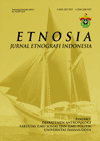‘Sembur’ culture: Local wisdom in care of pregnant mother with malaria in Kupang
DOI:
https://doi.org/10.31947/etnosia.v5i1.9344Keywords:
Malaria, sembur culture, pregnant mother, local wisdom.Abstract
Malaria is one of the main public health problems in the province of East Nusa Tenggara (NTT). NTT currently ranks second in malaria cases in Indonesia after Papua. Pregnant women are a risk group, data show that pregnant women suffering from malaria complications in Kupang District is still very high due to the delay in treatment since many patients dominate the primary care of the traditional healer compared to health services. The traditional healers use herbs that are sprayed (sembur)to the patient. This action is an alternative treatment carried out by the local community because it is far from health facilities. Therefore, this study aims to determine the picture of semburculture in pregnant women suffering from malaria in Kupang Regency. This study uses qualitative techniques with a phenomenological approach. The informants were chosen by using purposive sampling and snowball approach. There were six informants, all of whom came from Kupang Regency. The data collected through depth interviews and field notes. Processing and analyzing data in the form of interview results are converted into verbatim transcripts and the results of field notes are analysed in the form of transcripts. The results of this study show three themes from all participants; (1) health beliefs and practices; (2) thoughts and feelings when conducting a sembur culture; (3) hope for a future life. This research is beneficial for maternal and child health as well as educational and service institutions.Downloads
References
Ashley, E., McGready, R., Proux, S., & Nosten, F. (2006). Malaria. Travel Medicine and Infectious Disease. https://doi.org/10.1016/j.tmaid.2005.06.009
Badan Penelitian dan Pengembangan Kesehatan Kementerian Kesehatan RI. (2013). RISKESDAS 2013. website: www.litbang.depkes.go.id%0A
BPS Provinsi NTT. (2018). Jumlah Kasus Malaria Menurut Kabupaten/Kota di Provinsi Nusa Tenggara Timur, 2015-2018. https://ntt.bps.go.id/dynamictable/2018/08/31/764/jumlah-kasus-malaria-menurut-kabupaten-kota-di-provinsi-nusa-tenggara-timur-2015-2017.html
Briand, V., Cottrell, G., Massougbodji, A., & Cot, M. (2007). Intermittent preventive treatment for the prevention of malaria during pregnancy in high transmission areas. In Malaria Journal. https://doi.org/10.1186/1475-2875-6-160
Doku, D. T., Zankawah, M. M., & Adu-Gyamfi, A. B. (2016). Factors influencing dropout rate of intermittent preventive treatment of malaria during pregnancy. BMC Research Notes. https://doi.org/10.1186/s13104-016-2265-2
Dyah, A. . (2012). Pengalaman Ibu Hamil menderita malaria dalma merawat dirinya di Kabupaten Mimika Papua [Universitas Indonesia]. http://lib.ui.ac.id/bo/uibo/detail.jsp?id=20302559&lokasi=lokal.
Foster, G., & Anderson. (1986). Antropologi Kesehatan. UI Press.
Gaol, T. L. (2013). Pengaruh Faktor Sosiodemografi, Sosioekonomi dan Kebutuhan terhadap Perilaku Masyarakat dalam Pencarian Pengobatan di Kecamatan Medan Kota Tahun 2013. Tesis.
Geertz, C. (1981). Abangan, Santri, Priyayi dalam Masyarakat Jawa. Pustaka Jaya.
Ghana Health Service. (2009). Guidelines For Malaria In Pregnancy. http: //www.evidence.nhs.uk
Hawkins, P. (2012). Creating a coaching culture. Bell and Bain Ltd. https://www.academia.edu/7895334/CREATING_A_COACHING_CULTURE_by_Peter_Hawkins.
Hoelman, M. ., Parhusip, B., Eko, S., Bahagijo, S., & Santono. H. (2015). Panduan SDGs untuk pemerintah daerah (Kota dan Kabupaten). INFID. https://batukarinfo.com/referensi/panduan-sdgs-untuk-pemerintah-daerah-kota-dan-kabupaten-dan-pemangku-kepentingan-daerah
Kadir, Y.-. (2018). Dimensi Sosial Budaya Bagi Keragaman Praktik Perawatan Kesehatan Penderita Malaria di Topoyo Provinsi Sulawesi Barat. ETNOSIA : Jurnal Etnografi Indonesia. https://doi.org/10.31947/etnosia.v3i2.4154
Kamus Besar Bahasa Indonesia. (n.d.). https://kbbi.web.id/
Kapitan, M. (2013). Effect healthy mother package on knowledge and bahaviour of overcoming clinical symptoms during malaria attack among pregnant women in Southwest Sumba. Proceeding International Nursing Conference 3rd.
Kapitan, M., & Ludji, I. (2019). Pengalaman ibu hamil penderita malaria komplikasi di RSU Soe Timor Tengah Selatan. Jurnal Penyakit Bersumber Binatang The Journal of Zoonozis, 6(2 Maret).
Koentjaraningrat. (2000). Pengantar Ilmu Antropologi. Rineka Cipta.
Leiningier, M. dan, & McFarland, M. . (2002). Transcultural nursing: Concepts, theories, research and practice (Third). MC-Graw Hill Companies.
Okafor, I. ., Mbah, M., & USANGA, E. . (2012). The Impact of Anaemia and Malaria Parasite Infection In Pregnant Women. Nigerian Perspective. IOSR Journal of Dental and Medical Sciences. https://doi.org/10.9790/0853-0113438
Olorunfemi E Amoran, A, A. A., & A, I. C. (2012). Determinants of intermittent preventive treatment of malaria during pregnancy (IPTp) utilization in a rural town in Western Nigeria. Reproductive Health, 9(12), 1–8. https://reproductive-health-journal.biomedcentral.com/track/pdf/10.1186/1742-4755-9-12
Rosenstock, I. M. (1974). Historical origins of the health belief model. Health Education Monographs. Health Education Monographs. https://doi.org/http://dx.doi.org/10.1177/109019817400200403
Rospand, R. (2008). Pertimbangan budaya dalam pengkajian pasien. https://docplayer.info/31221394-Pertimbangan-budaya-dalam-pengkajian-pasien.html
Said M B. (1996). Dukun. Suatu Kajian Sosial Budaya tentang Fungsi Dukun Bugis Makassar di Kotamadya Ujung Pandang [Universitas Indonesia]. http://lib.ui.ac.id/detail?id=80532&lokasi=lokal
Schantz-Dunn, J., & Nour, N. M. (2009). Malaria and pregnancy: a global health perspective. Reviews in Obstetrics & Gynecology.
Soekanto, S. dan, & Sulistyowati, B. (2012). Sosiologi Suatu Pengantar. Rajawali Pers. id.wikipedia.org/wiki/Budaya yourarticlelibrary.com/culture/culture-the-meaning-characteristics-and-functions/9577
Soerachman, R dan Wiryawan, Y. (2013). Persepsi dan sikap masyarakat desa di Kabupaten Timor Tengah Selatan tentang melahirkan. Jurnal Kesehatan Reproduksi, 4(Nomor 1 April), 16–22.
Suparman, E., & Suryawan, A. (2004). Malaria pada Kehamilan. In Jkm.
Tim Riskesdas 2018. (2019). RISKESDAS 2018 LAPORAN PROVINSI NTT. Badan Penerbit BALITBANGKES.
Unicef Kupang. (2016). Akselerasi menuju eliminasi malaria di provinsi Nusa Tenggara Timur.
YOUNG, J. C. (1980). a model of illness treatment decisions in a Tarascan town. American Ethnologist. https://doi.org/10.1525/ae.1980.7.1.02a00070
















1.png)





